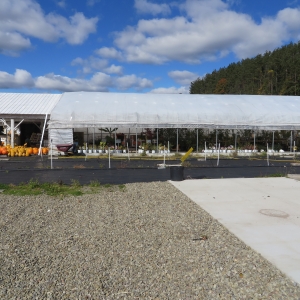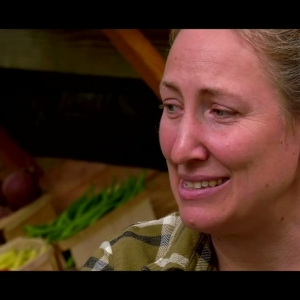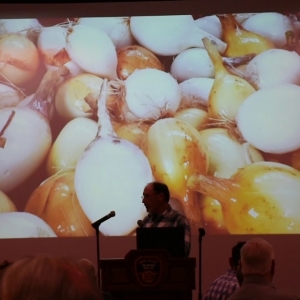Other Ag News:
A long-abandoned three-acre plot in the Washington Heights neighborhood of upper Manhattan will soon be home to a youth development program and flourishing urban farm.
Dr. Rosa Yolanda Pineda, pictured here in a 2024 farm field day hosted by Cornell Small Farms Program, is one of the principal drivers behind an urban farm and youth development project in upper Manhattan, where teens will grow crops and learn about soil health, marketing, and entrepreneurship. Photo provided by Connectemonos.
That’s the dream of Dr. Rosa Yolanda Pineda, one of the primary leaders of the project. Pineda and Omar Gonzalez did research on the plot in 2018 and started asking questions. “I’ve lived in Washington Heights for almost 50 years, and this piece of land has been abandoned for as long as I’ve been here,” she said. “It belongs to the Department of Education of New York City, and it’s basically in the backyard of a high school campus. What better use for that land than to make it an educational space for young people to learn to grow food?”
Pineda’s non-profit organization, called Connectemonos, or “Let’s Connect” in Spanish, has been doing youth development and empowerment work for more than 20 years. This urban farm project connects several of her passions.
Pineda was born and raised in Las Matas de Farfán, near the frontier with Haiti, in the province of San Juan, Dominican Republic, where her community grew beans, plantains, root vegetables and raised animals. “Particularly for those of us who grew up eating what we grew, I believe it’s a generational responsibility for us as immigrants to pass our knowledge on to our young people,” she said. “We need people to understand the importance of having healthy food options in the city.”
Pineda says young people in New York City don’t have enough opportunities to connect to their roots, both in the sense of their family traditions as well as the actual roots, stems, leaves, and vines that produce the food they eat.
She noted that urban youth get excited about growing food when they get a chance. “There’s a myth that kids today don’t want healthy food,” she said. “But everyone wants to eat well. It doesn’t matter if you’re rich or poor, or if you live in the country or the city.”
“This has always been an immigrant community, and a community of entrepreneurs,” Pineda continued. “We have gotten a lot of interest from restaurants. One in particular is a pizzeria where we want to incorporate locally grown vegetables into their menu. Everyone should have the option to choose healthy food where they live. We have to deal with the fact that places like Washington Heights are food swaps, lacking healthy food choices.This comes down to a justice issue.”
Justice, perhaps, is the essence of Pineda’s work. “In many places, we’re finding a loss of a sense of community, so we’re trying to find ways to show young people that they have alternatives,” she said. “They need to have spaces where they can realize the power they have. When young people are civically engaged, not only does it help them, it helps the whole community.”
Connectemonos delivers educational programming about social change, and a big part of that is acting locally. The organization works to reclaim green space and recreational spaces in Washington Heights. The urban farm will expand on that mission.
Pineda and others have already put a lot of sweat equity into the farm plot. From 2018 to 2020, Connectemonos organized cleanup days where members of the community came together to pull weeds and remove litter. By 2021, Superintendent Ramirez and the school campus community officially approved the use of the site. The city public school system has since taken responsibility for addressing structural issues like repairing retaining walls to make the site safe and accessible in 2025. Pineda expects to be given full authorization to start building raised beds and planting vegetables later this year.
This three-acre plot, undergoing structural improvements in early 2025, will soon be home to Manhattan’s largest urban farm, managed by the Connectemonos youth development project. Photo provided by Connectemonos.
Whether in a rural area or in a tucked-away corner of Manhattan, starting a farm requires a tremendous amount of planning. In preparation for getting the first seeds in the ground, Pineda and her colleagues have been working with the Futuro en Ag project of the Cornell Small Farms Program (CSFP) since 2023.
Pineda has attended several online and in-person events and trainings put on by Futuro en Ag, covering a range of topics from developing market channels to understanding farm taxes to raising chickens. She and colleague Ramón Toribio attended a two-day Spanish-language workshop for Latino/a/x farmers and aspiring farmers anchored by Futuro last winter, and they have been meeting regularly with Futuro technical staff to develop a business plan and a marketing plan.
Mildred Alvarado, director of the Equitable Farm Futures Initiative programming at CSFP, has found it a joy to work with the Connectemonos team.
“Connectemonos is not just a name,” said Alvarado. “Rosa Yolanda, Omar, and the rest of their team really connect with people, especially youth and the entire Latinx community. They are consistent in their mission to support young people through communing with the land and nature.
“Their example shows that it’s possible to dream and achieve what you set out to do when you work for it. It is a real pleasure to work with them,” she said.
María José Oviedo, a CSFP bilingual ag educator, is working with Connectemonos to develop resources related to soil health.
“In urban environments, understanding and implementing techniques related to soil health contributes directly to the project’s sustainability, improving soil structure and the availability of nutrients, making more efficient use of water, and many other things,” Oviedo said. “Also, adopting sustainable practices will increase the productivity of the soil and the quality of crops in the medium and long term.”
Oviedo hopes that among the achievements of the collaboration will be that young people will learn practices that will allow them to internalize key concepts and awaken their interest and creativity.
Pineda has found the relationship with CSFP eye-opening. The Futuro en Ag educational programs in Spanish put her in touch with Latino/a/x farmers from around the Northeast. She takes what she learns from others’ experiences and adapts the lessons to the urban context.
She admitted that there are many challenges ahead. “But I believe that the values we hold, our love of family and community, our hope – all of these things, we have to transmit them to the people around us,” Pineda said. “No one is going to come here and save us. We’re the ones who are here, so we’re the ones who will have to do it.”
The post Manhattan Urban Farm to Prioritize Youth Development appeared first on Cornell Small Farms.
There has been a lot of concern among ag employers and immigrant communities in New York about recent changes in federal immigration policy and enforcement.
First it is important to note that many of the rumors of drastically increased ICE presence in NYS are not true. An article in the Dispatch (a right of center media outlet with high rating for fact checking) “Trump’s Deportation Dilemma” reported recently that despite “Cops-style raids in cities across America” actual arrests and deportations are actually in keeping with or below the levels during the Biden and Obama administrations. The article points out that the majority of ICE arrests occur in prisons and jails.
“Because ICE gets 90 percent of them when they are booked into jail, they don’t miss that many targets. Even adding nonviolent and minor offenses to the list of arrest targets, along with “collaterals” non-criminal illegal immigrants incidentally swept up in enforcement – the pool of potential arrests is difficult to increase with existing ICE capacities.”
ICE’s X account (@ICE.gov) stopped posting daily arrest numbers at the end of January and is now posting details about individual criminals who are being arrested and deported. This strategy – of making a story about an individual for greater effect – is a well-known communications strategy for heightening the emotional response and it has the added advantage of minimizing the fact that deportation numbers are nowhere near the President Trump’s administration stated goals. Currently there are currently too few beds to house detainees, too few immigration judges and too few resources and not enough manpower.
That said, given the concerns of the agricultural community about increased ICE and US Customs and Border Protection enforcement, and this Administration’s stated policy goals of removing unauthorized individuals and reducing illegal immigration to the US, knowing what rights you have as a business owner and what rights your employees have can be empowering. The New York State Office for New Americans and the Cornell Farmworker Program are offering information to help immigrants and employers know their rights and how to respond and be prepared for interactions with Immigration and Customs Enforcement (ICE) and US Customs and Border Protection (CPB).
Here is a summary of information provided by the New York Immigrant Coalition:
- You always have the right to remain silent and not answer questions. Any information provided can be used against you later.
- You always have the right to refuse searches of your home, person or belongings by law enforcement, unless a judicial warrant is produced. But do not physically resist or interfere with them.
- You do not need to show identification. But do not lie or show false documents.
- You have the right to request an attorney
- You have the right to record law enforcement, including ICE agents, as long as you are not interfering with them.
Within the 100-mile Border Zone (which covers much of NYS) Customs Border Patrol Agents have some additional powers. The publication Immigrants and Upstate New York by the New York Immigrant Coalition specifically provides information about your rights when stopped by CPB. CPB agents can:
- Can stop you and ask questions about your citizenship or immigration status.
- Can enter onto private land within 25 miles of the border
- But they cannot enter a home or dwelling on private land anywhere without a judicial warrant or consent and
- They cannot conduct searches without a legal reason or consent.
Tips for Employers
The National Employment Law Project and National Immigration Law Center have put together a publication ”What to do if Immigration Comes to Your Workplace” that can provide some guidance. Here are some key takeaways:
ICE agents can enter public areas of a business, such as parking lots or lobbies, without restriction. However, they cannot access nonpublic (private) areas without consent of the owner or a valid judicial warrant.
It is a good idea to train your staff to refer ICE agents to you and not to allow ICE agents entry to private spaces (including worker housing). A worker can say “I can’t give you permission to enter, you must speak with my employer.”
It is important to know the difference between a judicial warrant and an administrative warrant. A judicial warrant, issued by a federal or state court and signed by a judge, specifies the search’s scope and location, which may include a private area. Employers must allow access to areas specified in the warrant but can refuse entry to nonpublic areas beyond the warrant’s authorizing scope. In contrast, an administrative warrant, which is not issued by a judge, does not authorize ICE agents to enter private spaces without permission. It directs law enforcement to arrest or detain specific individuals suspected of immigration violations but does not impose a legal duty on individuals or employers to comply with ICE demands.
I-9 Audits of Workplaces
With the heightened focus on immigration enforcement, an increase in I-9 audits and compliance investigations is anticipated. The Immigration Reform and Control Act of 1986 (“IRCA”) prohibits employing individuals unauthorized to work in the U.S. and requires employers to verify identity and employment authorization. Federal law mandates that employers timely complete an I-9 form for each employee to verify employment eligibility. The Cornell Ag Workforce Development Program has resources on I-9 forms for employers, including a presentation on Authorization to Work and Enforcement on January 8, 2025 and recorded the video.
Some best practices in I-9 records management:
1. You need to keep I-9s the longer of 3 years after the employee hire date or 1 year after the termination date. Shred old I-9s that you don’t need to keep so they are not a liability to you.
2. Along with the I-9s you will need to provide payroll lists but you do not need to provide individual pay records or personnel files – keep the HR files separate to control the information that is provided.
Finally, the resource, Immigrants & New York, also from the New York Immigration Coalition provides resources to help immigrants, particularly those with families and children, prepare for possible interactions with ICE. Tips include, making a child safety plan and finding someone to care for your child in the event of an emergency; making copies of important documents (birth certificates, medical and school records, passports); finding a good immigration lawyer; and tips on how to respond if interacting with ICE.
The Cornell Farmworker Program works on improving the living and working conditions of farmworkers and their families in New York State and beyond: https://cals.cornell.edu/global-development/our-work/programs/cornell-farmworker-program
The New York Immigration Coalition advocates for the rights of all immigrants in New York State: https://www.nyic.org/
The Cornell Agricultural Workforce Development works on developing the people who feed our local families and the world: https://agworkforce.cals.cornell.edu/
The post How to Prepare Your Yourself and Employees for an ICE/CPB Encounter appeared first on Cornell Small Farms.
NSAC has published an updated 2025 Farmers’ Guide to the Conservation Stewardship Program (CSP). The guide provides an in-depth look at the program and is designed to help farmers, ranchers, and foresters prepare and apply for this comprehensive conservation program that is authorized by the federal farm bill and administered by the US Department of Agriculture’s Natural Resources Conservation Service (NRCS).
What is CSP?The Conservation Stewardship Program (CSP) is the nation’s largest conservation program. It is a voluntary program that pays farmers and ranchers for the conservation they already do on their farms and for implementing new practices to help care for the soil, water, air, and wildlife. CSP contracts last five years and pay farmers an annual payment that covers their existing conservation practices and any new practices they implement as part of their contract.
While some USDA programs continue to experience difficulties related to the ongoing funding freeze created by the Administration’s Executive Orders, CSP continues to provide support for farmers via Farm Bill funding. NRCS is able to sign new contracts with farmers right now, though as USDA continues to experience across the board staffing reductions, producers seeking support through all conservation programs should anticipate longer-than-average delays in service and plan accordingly. NSAC strongly encourages producers dissatisfied with these new and unnecessary administrative delays to share concerns with their members of Congress.
What’s New in the Guide?This updated guide walks farmers and ranchers through some important updates to CSP in 2024, including:
- Increased minimum payments:
The minimum annual payment that farmers receive has been increased significantly from $1,500 to $4,000. This provides more meaningful support for smaller farms, guaranteeing that operations with fewer acres receive material benefit for their conservation efforts.
- New calculations for Existing Activity Payments:
CSP is unique in that it includes an annual payment for farmers already addressing resource concerns within their operations through ongoing conservation efforts. The formula to calculate those Existing Activity Payments has been changed, meaning that farms enrolling in new contracts going forward will receive a slightly larger payment under this updated formula to support the conservation practices they already use.
- Faster approval with Act Now:
CSP applications can now be fast-tracked through the Act Now process that pre-approves applications that meet a minimum ranking score. Farmers do not need to apply separately for Act Now: if their application meets the minimum score, it is automatically considered for pre-approval.
Updates to PaymentsCSP payments come in two parts: Existing Activity Payments that pay farmers for the conservation they already have in place and Additional Activity Payments that pay farmers for the new conservation they implement as part of their contracts. For contracts beginning in 2024 onwards, the formula for Existing Activity Payments has changed.
In the new formula, farmers get a per acre payment based on the land use. The per acre rate varies by land use and the number of resource concerns that already exceed the stewardship threshold (the minimum level of conservation performance that a farm or ranch must achieve to address specific natural resource concerns, which your NRCS agent will help to determine) when a farmer applies. Land use payment rates offered for FY24 contracts and beyond are:
Payment ExampleTo illustrate how the new EAP formula works, NSAC calculated a payment for a hypothetical farm. The example is a farm with 200 acres, 150 acres in cropland, and 50 acres in pasture. It is assumed that on the cropland acres, there are strong conservation practices in place that exceed the stewardship threshold (the minimum level of conservation performance that a farm or ranch must achieve to address specific natural resource concerns, which an NRCS agent will help to determine) for 5 resource concerns. On the pastured acres, it is assumed that the farm exceeds the stewardship threshold for 3 resource concerns.
This farm would also receive $1,800 annual payments (it would be $3,000 if they were a renewing contract) for either of the two land uses where they decide to implement new conservation practices as part of their contract. They are ambitious and plan to implement new conservation on both their cropland and their pasture, for a total of $3,600 of additional annual payments.
This farm’s annual Existing Activity Payment would be a total of $4,800. Under the old payment model, this farm would have received $4,214, so the new formula means that they will be paid $2,930 more over the course of their contract.
Finally, this farm would also receive payments to cover a portion of the cost of the new conservation practices they implement. While the previous two payments will stay the same for all five years of a contract (barring any major modifications), the payments for new activities will vary each year based on the schedule for implementing those practices.
Using these payment calculations, farms will receive anywhere from the minimum annual payment of $4,000 per year up to a maximum of approximately $40,000 per year for the length of their contract.
Check Out the Updated GuideThe 2025 Farmers’ Guide to the Conservation Stewardship Program walks farmers and ranchers through the program from interest, to application, to contract payments and monitoring. It shares stories of farmers who have had successful CSP contracts and the types of conservation that CSP can support. The guide contains more information about how and why to apply for a CSP contract. See NSAC’s recent report, Stewarding Success, to read about how CSP has performed under the 2018 Farm Bill.
This updated 2025 Farmers’ Guide to the Conservation Stewardship Program was supported by the California Climate and Agriculture Network (CalCAN).
The post Newly Updated Farmers’ Guide to the Conservation Stewardship Program Available appeared first on National Sustainable Agriculture Coalition.
Contact:
Laura Zaks
National Sustainable Agriculture Coalition
press@sustainableagriculture.net
Release: NSAC Applauds Introduction of the Organic Science and Research Investment ActWashington, DC, April 11, 2025 – Earlier this week, US Senators John Fetterman (D-PA) and Adam Schiff (D-CA) introduced the Organic Science and Research Investment Act, joined by Senators Kirsten Gillibrand (D-NY), Cory Booker (D-NJ), Jeff Merkley (D-OR), Tammy Baldwin (D-WI), Tina Smith (D-MN), Peter Welch (D-VT), Alex Padilla (D-CA), Ron Wyden (D-OR), and Angus King (I-ME). By ensuring organic research is prioritized at the US Department of Agriculture (USDA) and increasing funding for research agencies and universities, this bill would provide much-needed support to the organic farming industry.
“Pennsylvania is home to some of the best organic farmers in the world – and we need to support them in every way possible,” said Senator Fetterman. “I’m proud to introduce this bill to increase organics research within the federal government and at our leading research institutions to ensure our commonwealth can remain on the cutting edge of this growing industry. I’m grateful for Senator Schiff’s partnership as we work to pass this crucial support for American farmers.”
“America’s agriculture is the envy of the world, and agriculture research is essential to ensuring that food and farm organizations have the resources they need to grow food affordably, safely, and sustainably,” said Senator Schiff. “California is a leader in organic farming, and this legislation is essential for California farmers as they continue to be a driving force in the organic market.”
“NSAC applauds the introduction of the Organic Science Research and Investment Act, which makes meaningful investments in providing organic producers with the research and tools they need to continue to improve upon already resilient farming systems and meet the growing market demand for organic products” said Nick Rossi, Policy Specialist at the National Sustainable Agriculture Coalition (NSAC).
Find out more information about the bill here.
###
About the National Sustainable Agriculture Coalition (NSAC)The National Sustainable Agriculture Coalition is a grassroots alliance that advocates for federal policy reform supporting the long-term social, economic, and environmental sustainability of agriculture, natural resources, and rural communities. Learn more: https://sustainableagriculture.net/
The post Release: NSAC Applauds Introduction of the Organic Science and Research Investment Act appeared first on National Sustainable Agriculture Coalition.
The Futuro en Ag project of Cornell Small Farms Program continued to expand its educational offerings targeting Spanish-first farmers, supervisors, farm employees and aspiring farmers in New York State and beyond. We continue to be indebted to the hundreds of people who participated in our programming in 2024. You, your passions, and your dreams to live better lives and care of the land are the reason we do what we do.
If you would like to receive regular communications about activities and opportunities for Spanish-first and bilingual ag education, sign up here.
Here is a summary of our events and activities throughout the year.
The project held four bilingual farm field days in 2024:
- Ulster County, July 15.
- Tompkins County, July 28.
- Suffolk County, August 20.
- Orleans County, August 31.
- Two-day training on Communication and Organizational Culture, Tompkins County, May 29-30.
- Bilingual Workshop on Shiitake Mushroom Cultivation, Tompkins County, October 19.
- Two-day Leadership and Farm Management course, Suffolk County, October 24-25.
- Bilingual Technical Workshop, Rockland County December 6-7.
Online Courses and Trainings
- Jan-Feb. BF 102: Mercados y Rentabilidad para su Negocio Agrícola (Markets and Profits for Farm Businesses). 6 sessions.
- Apr-Nov. Juntos Aprendemos monthly learning circle. 8 sessions.
- Sep-Oct. BF 101: Cómo Iniciar su Negocio Agrícola (Starting Your Own Farm Business). 6 sessions.
In addition, our team made 10 farm visits for technical assistance and added 25 Spanish-language resources for farmers to our Centro de Recursos para Agricultores, including videos, articles, radio interviews, presentations on farm enterprises and finances, and more.
If you would like to receive regular communications about activities and opportunities for Spanish-first and bilingual ag education, sign up here.
Thank you for being part of the Futuro Community!
The post Futuro en Ag: 2024 Year in Review appeared first on Cornell Small Farms.
(Washington, D.C., April 4, 2025) — U.S. Health and Human Services (HHS) Secretary Robert F. Kennedy Jr. and U.S. Department of Agriculture Secretary (USDA) Brooke L. Rollins Thursday collaborated on their first Make America Healthy Again (MAHA) event during a visit to Ferdinand T. Day Elementary School in Alexandria, VA where they participated in a healthy snack time with students and met facility staff.
(Washington, D.C., April 4, 2025) – U.S. Secretary of Agriculture Brooke Rollins issued a Secretarial Memo (PDF, 2.9 MB) to establish an “Emergency Situation Determination” on 112,646,000 acres of National Forestry System (NFS) land (PDF, 19.8 MB). This Memo comes on the heels of President Donald J.
April is the Month of the Military Child. This year’s theme is “Celebrating Military Children and Youth: Building Stronger Character and Relationships.” The observance gives us an opportunity to recognize the unique challenges military children face and celebrate their amazing resilience and adaptability.
On January 20, 2025, President Trump’s executive order on American energy led to the freezing of projects funded by the Inflation Reduction Act (IRA), including stopped payments to recipients of the US Department of Agriculture (USDA)’s Rural Energy for America Program (REAP). More than $911 million in obligated funds through REAP have been frozen. On March 26, 2025, the USDA announced previously obligated REAP funds would be released.
The Rural Energy for America Program (REAP)
REAP provides grants and loan guarantees to help farmers, ranchers, and rural small businesses invest in renewable energy systems and energy efficiency improvements. This includes things like installing solar panels, upgrading to energy-efficient equipment, or improving building insulation. Through these investments, REAP helps farmers lower energy costs, boosts rural economic development, and supports the transition to clean energy in agricultural and rural communities. Like many USDA programs, it operates on a reimbursement model, meaning that farmers and small businesses have been waiting to be reimbursed for costs they have already incurred.
USDA’s Funding Notification
On March 26, 2025, the USDA began individually notifying REAP awardees with paused disbursements that they have 30 calendar days from the day of notice to “inform USDA Rural Development if they would like to voluntarily propose to change their projects within the existing project budget to better address President Trump’s January 20 Executive Order.”
The notification links to the following website: https://www.rd.usda.gov/reap-newera-pace-notification.
On this website, awardees may provide their Unique Entity Identifier (UEI) number, name, phone number, and email address, and indicate whether they have no changes to their current proposal or would like to request changes. If the latter option is selected, awardees are asked to provide a summary of their proposed changes, and a representative from USDA Rural Development will reach out to further discuss.
The following is based on NSAC’s current understanding that REAP grantees will receive the reimbursements that they are owed under their contracts, whether or not they choose to voluntarily update their projects. However, USDA’s guidance has been unclear in this, making this process more complicated for awardees.
Awardees may take the following three options:
- The awardee does not respond via the website. If this option is chosen, USDA says “disbursements and other actions” will resume after the 30 calendar days. While this language is vague, NSAC’s understanding is that there are no other actions for REAP recipients besides disbursements being considered at this time.
- The awardee responds via the website to confirm no changes. If this option is chosen, USDA will begin processing the awardee’s project immediately. NSAC’s understanding remains that choosing ‘no changes’ will not lead to any other action besides the processing of payments to be disbursed. At this time, press reporting suggests that payments are already being disbursed as this option is selected.
- The awardee responds via the website with proposed changes. USDA has said that changes “may include the removal of harmful DEIA project features, using more affordable and effective energy sources, including technologies to increase energy production, storage and improve customer service, or any other change that will help the recipient organization play their part in increasing American identification, leasing, development, production, transportation, refining, and generation capacity of energy and critical minerals, while providing affordable service to their customers.” However, once again, NSAC’s understanding is that this is voluntary and awardees are not required to suggest changes for their projects to receive reimbursements. In addition, suggested changes cannot exceed original award amounts and cannot change how the project was competitively scored at the time of its awarding, significantly limiting possible changes. If this option is chosen, a representative from USDA Rural Development will reach out to the awardee to confirm the changes do not affect the award amount and/or scoring, approve changes and update award documents, and begin processing reimbursements. Yet it is worth noting that recipients have not received any information from the agency specific to their grants that indicate what changes they might need to consider, if any, rendering this option quite vague and confusing.
For direct questions, REAP awardees can contact their state Energy Coordinators.
The post USDA Begins Releasing Frozen REAP Funding appeared first on National Sustainable Agriculture Coalition.
For Immediate Release
Contact: Laura Zaks, National Sustainable Agriculture Coalition
Email: press@sustainableagriculture.net
Comment: NSAC Calls for Comprehensive Farm Bill, Addresses Likely Long-Term Cuts to Farm and Food Programs in Budget ProcessWashington, DC, April 3, 2025 – Today, the National Sustainable Agriculture Coalition (NSAC) issued the following statement after yesterday’s release of the fiscal year (FY) 2025 budget resolution, and amidst the mounting potential for deep cuts to farm and food programs, attributable to Mike Lavender, NSAC Policy Director.
“The federal farm bill touches every aspect of American life – from farmers and ranchers, rural development, conservation, domestic market opportunities provided through local and regional food systems, and consumers. There is simply no replacing the farm bill.
Using the budget reconciliation process to dramatically slash farm bill programs that invest in so many families and communities – from nutrition assistance and beyond – in order to increase reference prices and expensive subsidies that benefit so few is the antithesis of a farm bill. A move like this from Congress would prioritize the few over the many, and simultaneously make it even harder to reauthorize a genuine farm bill.
It has been more than six years since the bipartisan Agriculture Improvement Act of 2018 was signed into law by President Trump during his first term. NSAC is not alone in our eagerness for a new, full farm bill – farmers and farmer–serving organizations across the country share this sentiment. We cannot squander any opportunity to truly invest in the long-term economic viability of our nation’s farmers through a full farm bill by instead prioritizing short-term bandages through budget reconciliation. A stand-alone farm bill simply cannot and should not replace budget reconciliation – they are fundamentally different.”
###
About the National Sustainable Agriculture Coalition (NSAC)The National Sustainable Agriculture Coalition is a grassroots alliance that advocates for federal policy reform supporting the long-term social, economic, and environmental sustainability of agriculture, natural resources, and rural communities. Learn more: https://sustainableagriculture.net/
The post Comment: NSAC Calls for Comprehensive Farm Bill, Addresses Likely Long-Term Cuts to Farm and Food Programs in Budget Process appeared first on National Sustainable Agriculture Coalition.
Pages
Signup for the Ag Newsletter
Get the freshest farm news, events and updates from in and around Cattaraugus County, NY at least once a month! Go signup!
Other ways to stay connected:
Get Involved in Farming
Resources for Starting a Farm in Cattaraugus County
Profile of Cattaraugus County soils
Agriculture Career Exploration
Questions about farming? Find out Who to Call











